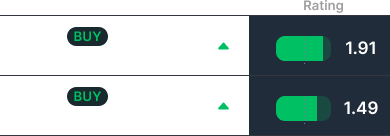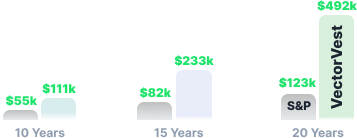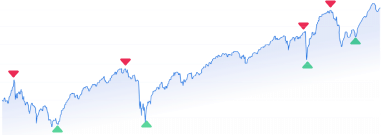The elusive art of market timing is often debated in the trading world and poses a tantalizing question: Can you time the market? The answer may surprise you.
Many traders grapple with this challenge, oscillating between hope and hesitation, seeking a way to make informed decisions without being overwhelmed by stress and guesswork. But the answer is yes – you can time the market if you have the right mindset paired with the right swing trading tools!
We’ll walk you through a few success stories and discuss the feasibility of market timing before introducing you to VectorVest, a groundbreaking solution that tells you what to buy, when to buy it, and when to sell it.
The complexities of market timing are simplified with VectorVest, turning this daunting task into a more manageable, data-driven process. But before we teach you how to time the market, let’s get you up to speed on what all this strategy entails.
What Does it Mean to “Time the Market”?
First things first – what is market timing? This is a strategy based on the idea of predicting market trends to make profitable trades.
It involves buying or selling financial instruments like stocks or bonds, not solely based on their fundamental value but on anticipating how market prices will move in the short term.
This approach contrasts with the ‘buy and hold’ strategy, where investments are made for the long term, regardless of market fluctuations. You can learn more about these differences in our guide comparing buy and hold vs market timing or timing the market vs time in the market.
Market timing is often viewed as a sophisticated approach that requires keen insight into market trends, economic indicators, and even investor psychology. The goal is to buy low and sell high, capturing gains by entering and exiting the market at the most opportune moments.
However, it’s a strategy shrouded in debate, with many arguing about its effectiveness due to the market’s inherent unpredictability and complexity. So, can you time the market?
Can You Time the Market?
Just as with questions like – should I buy stocks when they are low or high? – there is no one size fits all answer to this question. So let’s talk about some of the challenges in successfully implementing market timing strategies, and then, show you what’s possible with the right technology and mindset.
The Challenges in Timing the Market
Let’s be clear – does market timing work? Yes – but most who attempt to time the market end up failing. That’s because they don’t fully understand the principles and/or they don’t have the best swing trading platform in their arsenal, though.
The truth is that timing the market is hard to do on a consistent basis. There are a few reasons why – the first being market volatility. The stock market is influenced by myriad factors, ranging from global economic news to industry-specific trends and investor sentiment, making it inherently volatile and unpredictable.
But perhaps the biggest reason individuals fail to effectively time the market is emotion. Many traders fall prey to emotional biases, making impulsive decisions based on fear or greed rather than rational analysis.
The good news? We’ll walk you through the process of buying the dip based on a tried-and-true system in just a moment, helping you time the market with ease. But first, let’s look at some real-life success stories showing that yes, you can time the market.
Success Stories: Yes, You Can Time the Market!
So, can you time the market? Despite the challenges we’ve mentioned, there is no shortage of success stories. These demonstrate that market timing can be effective with the right strategy and tools. VectorVest offers a compelling example of this.
Our system is based on mathematical modeling and analyzes market trends using a unique Value, Safety, and Timing (VST) methodology.
This approach has successfully identified major market turning points over the past 25 years, including the Dot Com Bubble, the 2008 Global Financial Crisis, and the Coronavirus Crash.
During these periods, VectorVest’s market timing indicators not only warned subscribers of impending downturns but also advised them on when to re-enter the market, leading to substantial gains.
Tips on Timing the Market Without the Guesswork and Stress
Whether you’re just getting started with swing trading for beginners or you’re now trying to fine-tune your strategy and maximize your trading profits while minimizing losses, the concept of market timing is obviously tantalizing.
But, actually putting it all together is easier said than done – especially if you’re trying on traditional stock technical indicators and other outdated approaches.
Still, we want to walk you through how to do technical analysis of stocks and how to do fundamental analysis of stocks to help you understand the underlying principles.
But, we’ll also show you how you can bypass all this complexity and wasted time with our intuitive stock advisory afterward!
Traditional Approaches Used to Time the Market
Learning how to analyze stocks to time the market is critical, as this is how you’ll identify a potential upswing/downswing and validate your findings. There are many ways you can go about this, and you’ll likely rely on a combination of analysis:
- Chart Patterns and Trends: You’ll want to look for swing trading patterns like head and shoulders, triangles, or flags that historically indicate future price movements. Understanding these patterns helps in predicting market trends and potential reversals. Just be sure you’re using the best time frame for swing trading.
- Volume Analysis: Volume, or the number of shares traded during a given period, is a crucial indicator in technical analysis. High trading volumes often confirm the strength of a market trend, either bullish or bearish, providing insights into potential market movements.
- Moving Averages: These are used to smooth out price data to identify the trend direction. Short-term and long-term moving averages, like the 50-day and 200-day moving averages, are often monitored for crossovers, which can signal entry and exit points. Learn more about the best moving average for swing trading in our blog.
- Momentum Indicators: Tools such as the Relative Strength Index (RSI) and Moving Average Convergence Divergence (MACD) help in identifying overbought or oversold conditions, which can be precursors to market reversals. We encourage you to learn more about these indicators for swing trading in our blog as well.
You should also dig deeper in a stock and look at it fundamentally to assess its financial health. Ratios like price-to-earnings (P/E), debt-to-equity, and return on equity (ROE) are scrutinized to assess a stock’s intrinsic value.
It’s also important to consider broader economic indicators like GDP growth, unemployment rates, and inflation. These indicators can have a significant impact on market performance and help in timing investment decisions.
Of course, investor sentiment plays a critical role in figuring out when to buy stocks as well. This helps you gauge how the rest of the market is feeling either in general or about a certain stock. From there, you can follow the trends or consider contrarian investing.
As you can see, there is a lot that goes into timing the market through traditional methods. But, what if you could save yourself the time and headaches of learning technical analysis and learning fundamental analysis, all while setting yourself up for more successful trades?
Our stock analysis software makes it possible.
How VectorVest Simplifies Your Strategy and Empowers You to Win More Trades With Less Work
VectorVest transforms the often overwhelming task of market timing into a more manageable and successful endeavor. It empowers traders to make informed decisions with confidence and ease by distilling complex market data into clear, actionable insights.
At the heart of VectorVest’s system are the VST ratings. Each stock is assigned a rating for its Value, Safety, and Timing.
- Value assesses a stock’s relative worth
- Safety measures its risk and predictability
- Timing indicates the stock’s price momentum.
These ratings are combined into an overall VST score, simplifying the decision-making process. Based on these ratings, you’re presented with a clear buy, sell, or hold strategy – transforming your stock picking strategy for the better! No more guesswork over when to enter or exit your positions.
But, the relative timing (RT) indicator is the most important for those seeking to time the market. It speaks to the direction, dynamics, and magnitude of a given stock’s price movement. Like all VST ratings, it sits on an easy-to-understand scale of 0.00-2.00, with 1.00 being the average.
So, how can you time the market with VectorVest? Actually using the RT rating to time the market is simple. A rating rising above 1.00 indicates a strong positive price trend, and signals that it may be time to buy (provided the RV and RS rating match up with your trading strategy as well). A falling RT rating suggests the price trend is weakening.
But, the reason VectorVest is considered the best app for stock analysis is that it does so much more than help you time your trades. Whether you’re a swing trader or day trader, position trader, or even trying to invest for early retirement, you can find your next trades on autopilot through the system’s pre-curated screeners.
These screeners rank over 18,000 stocks daily, and bring the best opportunities to your fingertips. You can find the best stocks for swing trading, best stocks for day trading, best starter stocks, or any other stocks for that matter!
The time and stress typically involved in market analysis and timing are significantly reduced, allowing you to focus on executing winning trades. But, why not see the system in action with a free stock analysis?
Final Thoughts on Whether or Not You Can Time the Market
So, can you time the market? Yes, as long as you have VectorVest in your arsenal! While timing the market is a complex endeavor steeped in various traditional and modern methodologies, it is not an unattainable skill.
With the right tools, strategies, and insights, investors can navigate market dynamics more confidently. VectorVest stands at the forefront of this challenge, offering a comprehensive solution that demystifies market timing.
You can find more tips for swing trading in our blog. We have resources on topics like cutting losses, swing trading options, selecting stocks for swing trading, investing in a down market, when to sell stocks at a loss, the best time to buy stocks, the difference between fundamental analysis and technical analysis, scalping vs swing trading, and more.
By investing in VectorVest, you’re not just gaining access to a powerful tool; you’re empowering yourself with reliable, data-driven market insights. Take control of your trading journey with VectorVest today!
What you should do next…
- Get our latest blogs delivered right to your inbox, subscribe to our newsletter.
- The market moves fast! Get our most current evaluation of this stock with our FREE stock analysis tool.
- Looking for stock picks? Not sure if now is the right time to buy/sell? For a limited time, enjoy the full benefits of a 30-day subscription to VectorVest for only [offer_txt] (usually up to [saving_txt]/month) . Get access to our full list of screeners showcasing our top stock picks that tell you exactly what to buy, when to buy, and when to sell.












